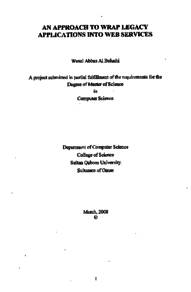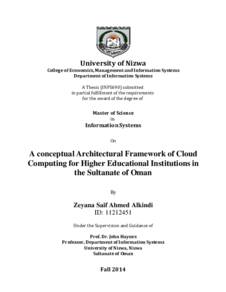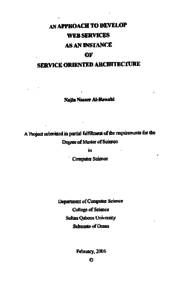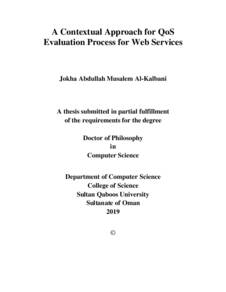Document
An approach to wrap legacy applications into Web services
Publisher
Sultan Qaboos University
Gregorian
2008
Language
English
Subject
English abstract
Web services are rapidly becoming the de facto standard realization of the Service Oriented Architecture (SOA) due to: (i) the machine-readable standard format (XML) of their functional and non-functional specifications, and (ii) their messaging protocols which can be built on top of the Internet protocols. However their development with respect to SOA requires a methodology including a development life cycle. This development methodology needs to consider the legacy applications for several reasons including: (1) SOA is based on composing new solutions from existing loosely coupled services rather than building them from scratch, (2) legacy applications have most of the business functions locked inside of them, and (3) legacy applications constitute an important asset for the enterprise that should be modernized and preserved as investments.
There exist numerous automated tools to wrap legacy applications and expose them as Web services. Generally these tools consist of simply placing a thin layer of SOAP/WSDL/UDDI on top of legacy applications. While these tools have several features to wrap different parts of the legacy application (data, logic, or interface), they do not provide a proper guidance on which feature is most suitable for the target legacy application with respect to its accessibility (transaction, data or session based access).
This project mainly aims at defining an approach to wrap any legacy application with respect to its accessibility and expose it as a Web service regardless of the wrapping tool in use. It consists of an exploration and a survey of respectively several projects and automated wrapping tools concerned with wrapping and exposing legacy applications as Web services. This exploration has resulted in a categorization of the wrapping techniques into three basic categories: Transaction, Data, and Session Based Techniques. This categorization has guided an approach to wrap legacy applications as Web services. The proposed approach consists of four phases: (P1) identification and analysis of the legacy application, (P2) extraction of the business rules from the legacy application, (P3) selection of the suitable wrapping technique, and (P4) design and deployment of a Web service. The approach is illustrated through a student information system as a validation case study.
Member of
Resource URL
Arabic abstract
أصبحت خدمات الشبكة العالمية (Web services) من المعايير الأساسية لتطبيق البنية الموجهة للخدمات (SOA)، وذلك للأسباب التالية: (1) مواصفاتها الوظيفية وغير الوظيفية قابلة للقراءة اليا عن طريق لغة الترميز القابلة للامتداد (XML)، (2) قوانین مراسلاتها مبنية على قوانين وبروتوكولات الانترنت. ولكن في الجانب الآخر، خدمات الشبكة العالمية بحاجة إلى الية تطوير منهجية لجعلها متطابقة لمتطلبات SOA. عند تبني أي الية لتطروير الخدمات الشبكية لابد من الأخذ في الاعتبار الأنظمة القديمة ( Legacy Applications) وذلك لأن: (1) SOA تعني بتطوير الأنظمة القديمة بدلا من بناء أنظمة جديدة (2) الأنظمة القديمة تمتلك قدرا كبيرا من المعلومات المتعلقة بالقوانين والاجراءات. (3) الأنظمة القديمة عبارة عن رصيد متراكم من المعرفة والجهد والوقت فيجب الحفاظ على هذا الاستثمار.
يوجد العديد من البرامج الالية التي تقوم بالتعامل مع الأنظمة القديمة وعرضها على هيئة خدمات شبكية. وبالرغم من أن هذه البرامج تشمل عدة سمات للتعامل مع الأنظم القديمة إلا أنها لا تقدم توجيه وتوضيح عن السمات الأكثر تناسبا مع النظام القديم المراد تطويره.
هذا المشروع يهدف بالدرجة الأولى إلى تحديد خطوات منهجية لعرض الأنظمة القديمة على هيئة خدمات شبكية بغض النظر عن البرنامج الالي المستخدم. ويتألف هذ المشروع من دراسة استقصائية لبعض البرامج والمشاريع المتعلقة بتعريض الأنظمة القديمة على هيئة خدمات شبكية ، وقد أسفرت هذه الدراسة عن تصنيف الية تعريض الأنظمة القديمة إلى ثلاث تقنيات متعلقة ب: الأجرات، والبيانات وواجهة النظام. الخطوات المنهجية المقترحة تتضمن أربع مراحل، وهي: (1) دراسة وتحليل النظام القديم، (2) استخراج القوانين والاجرات المتبعة من النظام القديم، (3) اختيار الية تعريض الأنظمة القديمة كخدمات شبكية، (4) تصميم ونشر الخدمات الشبكية. وقد تم توضيح هذه الخطوات المنهجية عن طريق تطبيقها على نظام معلومات الطلاب.
يوجد العديد من البرامج الالية التي تقوم بالتعامل مع الأنظمة القديمة وعرضها على هيئة خدمات شبكية. وبالرغم من أن هذه البرامج تشمل عدة سمات للتعامل مع الأنظم القديمة إلا أنها لا تقدم توجيه وتوضيح عن السمات الأكثر تناسبا مع النظام القديم المراد تطويره.
هذا المشروع يهدف بالدرجة الأولى إلى تحديد خطوات منهجية لعرض الأنظمة القديمة على هيئة خدمات شبكية بغض النظر عن البرنامج الالي المستخدم. ويتألف هذ المشروع من دراسة استقصائية لبعض البرامج والمشاريع المتعلقة بتعريض الأنظمة القديمة على هيئة خدمات شبكية ، وقد أسفرت هذه الدراسة عن تصنيف الية تعريض الأنظمة القديمة إلى ثلاث تقنيات متعلقة ب: الأجرات، والبيانات وواجهة النظام. الخطوات المنهجية المقترحة تتضمن أربع مراحل، وهي: (1) دراسة وتحليل النظام القديم، (2) استخراج القوانين والاجرات المتبعة من النظام القديم، (3) اختيار الية تعريض الأنظمة القديمة كخدمات شبكية، (4) تصميم ونشر الخدمات الشبكية. وقد تم توضيح هذه الخطوات المنهجية عن طريق تطبيقها على نظام معلومات الطلاب.
Category
Theses and Dissertations




